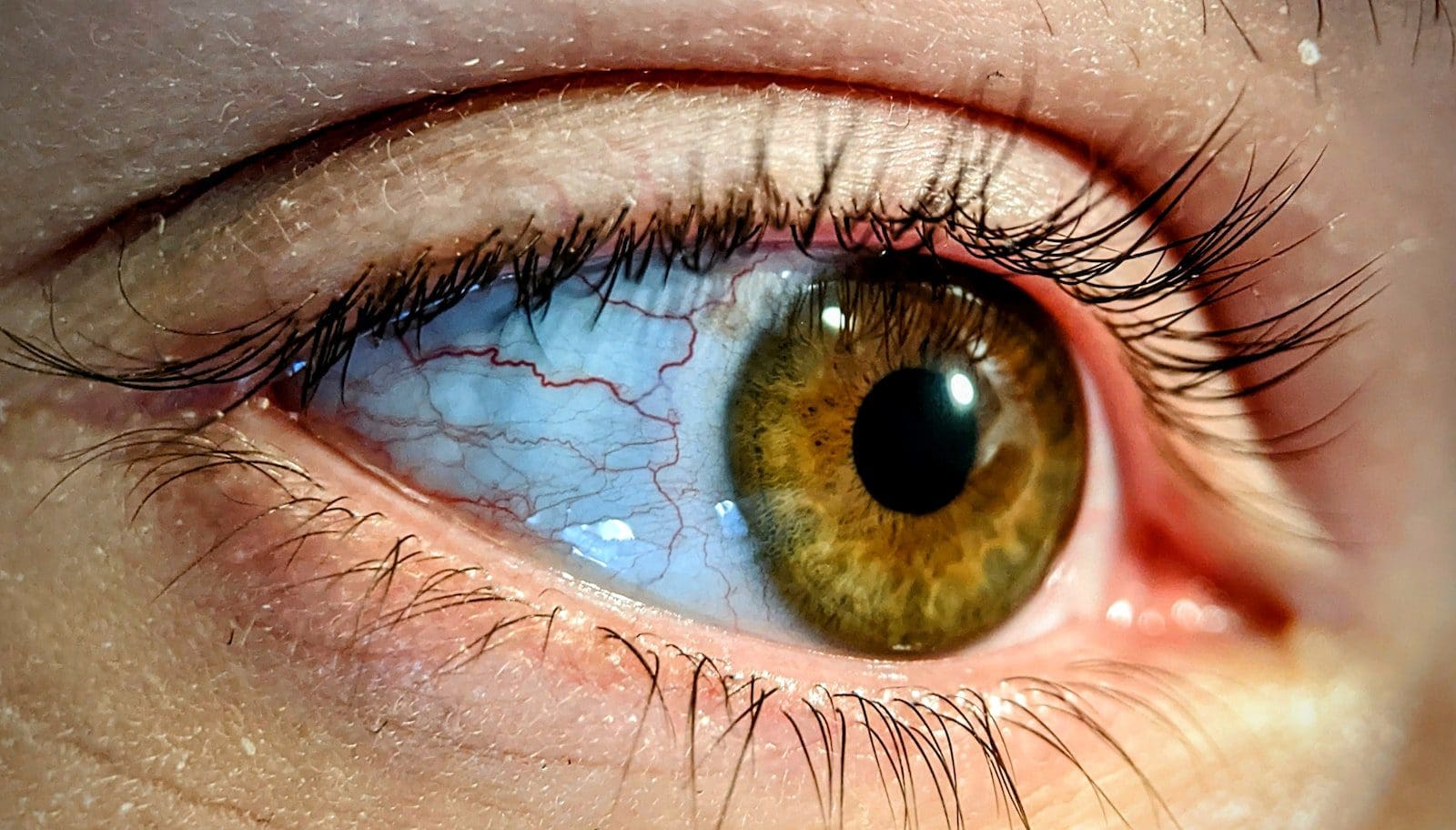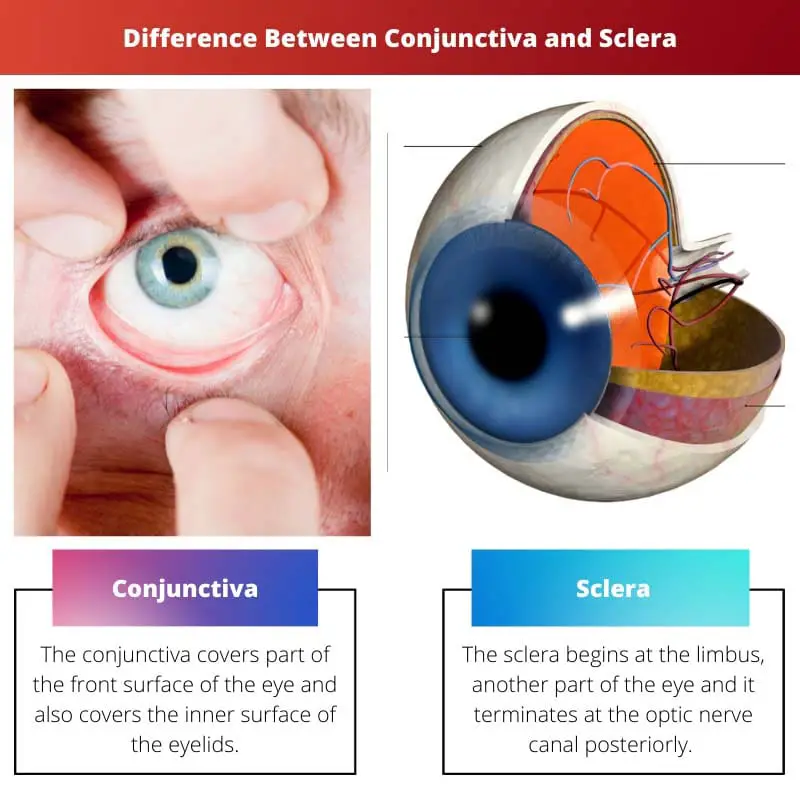The conjunctiva is a thin, transparent membrane covering the sclera—the white outer layer of the eye. It serves to protect the eye from foreign particles and provides lubrication for smooth eye movement. While the conjunctiva is rich in blood vessels, giving it a pinkish hue, the sclera is dense, tough, and maintains the shape of the eye.
Key Takeaways
- Conjunctiva is a thin, transparent membrane that covers the eye’s front surface and lines the eyelids inside.
- Sclera is the white outer layer of the eyeball that provides structural support and protection.
- Conjunctiva is susceptible to infection and irritation, while the sclera is not.
Conjunctiva vs Sclera
Sclera, which is also called the white of the eye, is a thick protective membrane of the eye. The conjunctiva is a thin membrane which covers the sclera except cornea. The sclera is mainly made up of fibers and is opaque while the conjunctiva mainly contains vessels and is translucent.

Comparison Table
| Feature | Conjunctiva | Sclera |
|---|---|---|
| Function | Protects the eye, lubricates the eyeball, | Provides structural support, maintains the shape |
| fights infection | of the eyeball, attaches extraocular muscles | |
| Location | Covers the white part of the eyeball (sclera) | The white part of the eyeball visible from outside |
| and the inner surface of the eyelids | ||
| Color | Transparent or pinkish | White |
| Thickness | Thin, translucent membrane | Thick, opaque layer |
| Blood Supply | Rich in blood vessels, appears pink | Sparse blood vessels, appears white |
| Nerve Supply | Abundant nerves, sensitive to touch | Fewer nerves, less sensitive |
| Goblet Cells | Present, produce mucus for lubrication | Absent |
| Lymphatic Tissue | Present, helps fight infection | Absent |
What is Conjunctiva?
The conjunctiva is a mucous membrane that covers the front surface of the eye and lines the inside of the eyelids. It plays a crucial role in maintaining eye health and functionality.
Structure of Conjunctiva
- Bulbar Conjunctiva: This thin, transparent membrane covers the sclera, the white part of the eye. It extends from the edge of the cornea to the fornix, where it meets the palpebral conjunctiva.
- Palpebral Conjunctiva: This portion lines the inside surface of the eyelids, extending from the eyelid margins to the fornix.
Functions of Conjunctiva
- Protection: It acts as a protective barrier, shielding the delicate structures of the eye from foreign particles, irritants, and pathogens. This protection helps prevent infections and maintains ocular health.
- Lubrication: The conjunctiva produces mucus and tears, contributing to the tear film that lubricates the surface of the eye. This lubrication ensures smooth eye movement, prevents dryness, and enhances visual clarity.
- Immunological Defense: The conjunctiva contains a network of immune cells and antibodies, helping to defend against infections and allergic reactions. It plays a role in the eye’s immune response by detecting and neutralizing pathogens.
Conjunctival Disorders
Various conditions can affect the conjunctiva, including conjunctivitis (commonly known as pink eye), allergic reactions, dry eye syndrome, and conjunctival tumors. Proper hygiene, regular eye exams, and timely treatment are essential for maintaining conjunctival health and preventing complications.

What is Sclera?
The sclera is the tough, fibrous outer layer of the eye that helps maintain its shape and protect the delicate internal structures. It is commonly referred to as the “white of the eye” due to its opaque appearance.
Structure of Sclera
The sclera is composed mainly of collagen fibers arranged in a dense, irregular connective tissue matrix. It extends from the corneal limbus (the border between the cornea and sclera) to the optic nerve at the back of the eye. The sclera is thickest at the back of the eye and gradually thins towards the front, where it merges with the cornea.
Functions of Sclera
- Protection: One of the primary functions of the sclera is to protect the internal structures of the eye, including the retina, choroid, and vitreous humor. Its tough and resilient nature helps shield the eye from injury, impact, and external trauma.
- Support: The sclera provides structural support for the eye, helping to maintain its shape and integrity. It helps to distribute intraocular pressure evenly, preventing the eye from collapsing under the forces exerted by the intraocular fluids.
- Attachment: Various muscles and ligaments of the eye attach to the sclera, enabling eye movement and proper function of the visual system. These attachments allow for precise control of eye movements, facilitating activities such as tracking objects and maintaining binocular vision.
Scleral Disorders
- Scleritis: This is a rare but serious inflammatory condition characterized by severe pain, redness, and swelling of the sclera. It can be associated with autoimmune diseases such as rheumatoid arthritis.
- Episcleritis: Unlike scleritis, episcleritis is a milder inflammation of the episclera, a thin layer between the sclera and conjunctiva. It causes mild discomfort and redness but resolves without complications.
- Myopia (Nearsightedness): In individuals with myopia, the eyeball elongates, causing the sclera to stretch. This elongation can lead to thinning of the sclera and an increased risk of conditions such as retinal detachment.

Main Differences Between Conjunctiva and Sclera
- Location:
- Conjunctiva: Covers the front surface of the eye and lines the inside of the eyelids.
- Sclera: Forms the outermost layer of the eye, surrounding the eyeball.
- Composition:
- Conjunctiva: Consists of a thin, transparent mucous membrane.
- Sclera: Composed of dense, fibrous connective tissue rich in collagen fibers.
- Appearance:
- Conjunctiva: Typically appears pinkish due to underlying blood vessels.
- Sclera: Appears white and opaque, referred to as the “white of the eye.”
- Function:
- Conjunctiva: Protects the eye from foreign particles, provides lubrication, and contributes to the tear film.
- Sclera: Provides structural support to maintain the shape of the eye and protect internal structures.
- Associated Disorders:
- Conjunctiva: Can be affected by conditions such as conjunctivitis (pink eye), allergic reactions, and dry eye syndrome.
- Sclera: Disorders may include scleritis, episcleritis, and myopia (nearsightedness) due to elongation and thinning of the sclera.
- Location of Disorders:
- Conjunctiva: Disorders primarily affect the conjunctival tissue.
- Sclera: Disorders primarily affect the scleral tissue.






